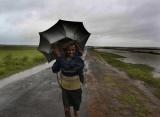Hyderabad, Nov 22: Helen, the cyclonic storm in Bay of Bengal, is heading to hit Andhra Pradesh coast later in the day while several parts of the region started receiving heavy rains under its impact.
An alert has been sounded in the coastal districts, while authorities are taking precautionary measures including evacuation of people from low-lying area to minimize the damage from the cyclone in the Bay of Bengal.
According to the Indian Meteorological Department (IMD), the severe cyclonic storm will cross the coast near Machillipatnam around Friday afternoon.
IMD has issued cyclone warning to Andhra Pradesh coast.
The IMD's bulletin early Friday said 'Helen' over west central Bay of Bengal moved slightly west-northwestwards and lay centred at about 120 km east of Machillipatnam, 250 km east-northeast of Ongole and 200 km south-southwest of Vishakhapatnam.
It would move west-northwestwards for some time, then westward and cross Andhra Pradesh coast near Machillipatnam.
Heavy rains accompanied by strong gales are lashing Krishna, Visakhapatnam, West Godavari and some other parts of the coastal region since early Friday. Authorities have declared holiday for educational institutions.
Under the influence of cyclone, rainfall at most places with heavy to very heavy rainfall at a few places would occur over north coastal Andhra Pradesh and adjoining Guntur, Krishna, West Godavari districts of south coastal Andhra Pradesh during next 48 hours. Isolated extremely heavy falls (25cm or more) are also likely.
Rainfall at most places with isolated heavy to very heavy falls would occur over remaining districts of south coastal Andhra Pradesh Rayalseema and Telangana Friday and Saturday.
Squally winds speed reaching 55-65 kmph gusting to 75 kmph would prevail along and off south Andhra coast. The wind speed would gradually increase up to gale wind speed of 100-110 kmph, gusting to 120 kmph at the time of landfall.
The IMD has warned that storm surge of about 1 to 1.5m height would inundate the low lying areas of west and east Godavari Krishna, Guntur and adjoining areas of Prakasham district at the time of landfall.
Sea condition will be rough to very rough along and off south Andhra coast. Extensive damage to thatched roofs and huts and minor damage to power and communication lines was expected due to uprooting of trees.
Fishermen have been advised not to venture into the sea. The authorities have hoisted warning signals at all ports along Andhra coast.
Chief Minister N. Kiran Kumar Reddy, who reviewed the situation in coastal districts with top officials at a meeting in Hyderabad Thursday, directed the chief secretary to closely monitor the situation with all collectors of coastal districts to face any eventuality.
A control room to monitor the situation has been opened at the state secretariat in Hyderabad. The control room numbers are 040-23456005, 23451043.
Krishna district collector Raghunandan Rao said a holiday was declared for all educational institution in coastal areas.
He said 10 relief camps were opened for people evacuated from low-lying areas. Sixty personnel of National Disaster Response Force ( NDRF) personnel were deployed for rescue and relief operations.
A control room in Krishna district collector's office was opened. Its telephone numbers are 08672-252572 08672-251077.
Helen is threatening Andhra coast even as the state is yet to recover from the massive damages caused by 'Phailin' and heavy rains in October.
Andhra Pradesh has nearly 1,000 km long coastline and the nine district faces cyclone threats every year, especially between September and November.





Comments
Add new comment